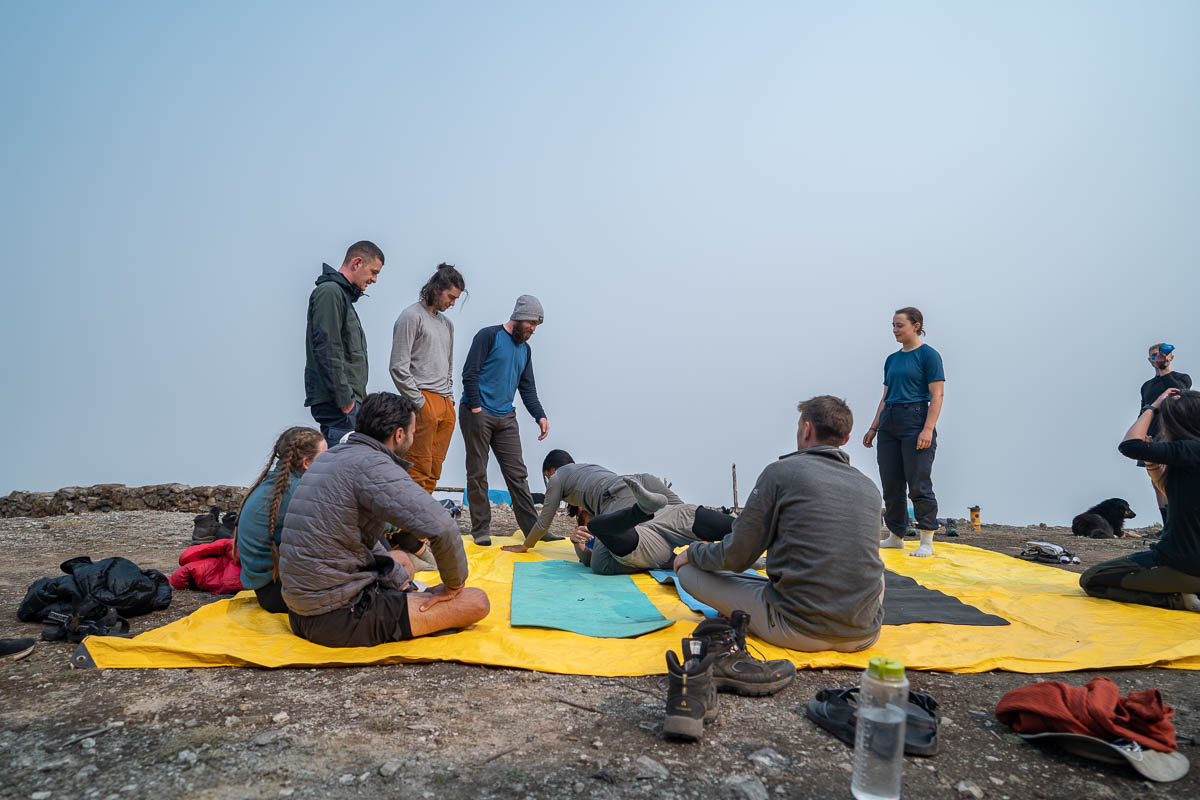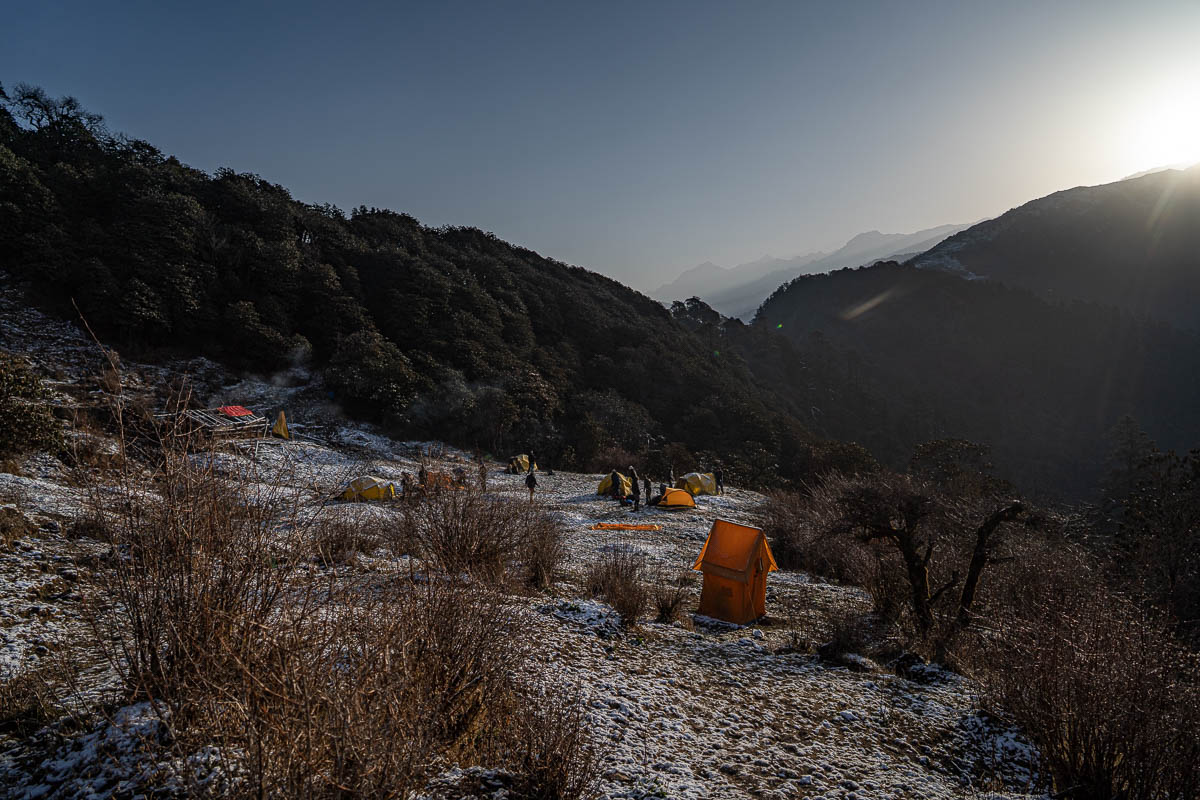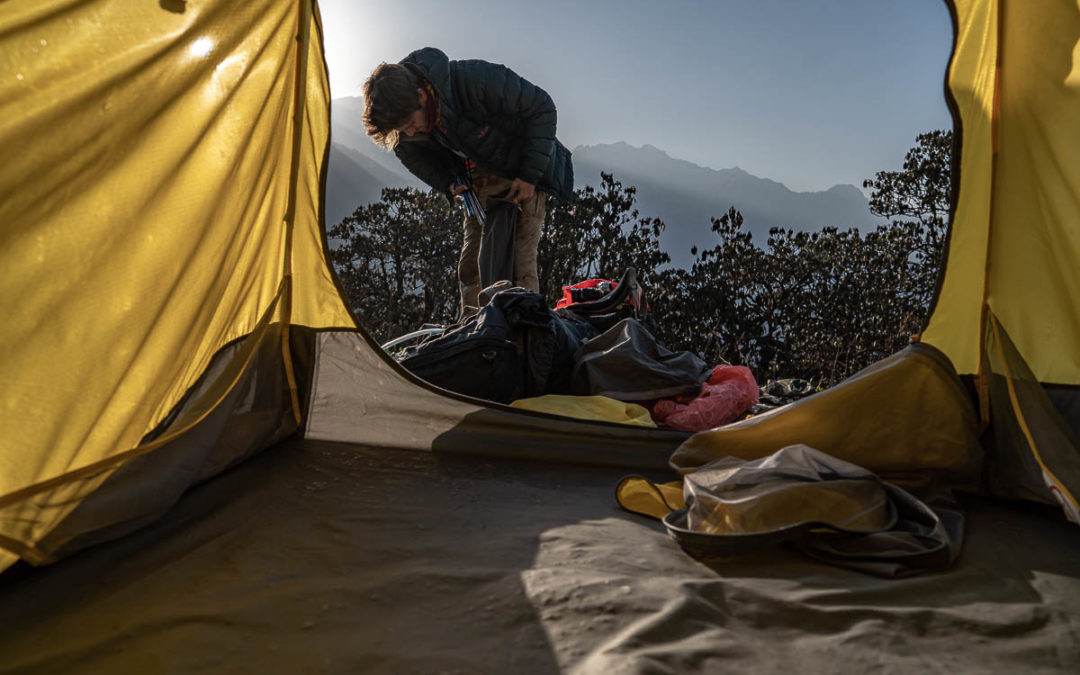After five days of consecutive trekking through Langtang National Park in the Himalayas, a rest/ admin day was very much welcomed by the group. We had come 35k (22mi) climbing 3,150m (10,325ft) to get to our campsite at Thadepati. Our camp was situated along a ridge with spectacular views of the mountains in all directions, but most impressively to the north. This was also the first place in five days that we were able to access Wi-Fi and a charging station which were other bonuses. There were no showers aside from a little ice-cold stream of water a mile down the mountain, so I opted for more deodorant instead. Lastly, there was a wonderful large wood fired room in the guesthouse above our campsite which became a nice place to retreat to at the days end to warm up in before heading to our tents.
On our first rest day, also Easter Sunday, the majority of the group opted for a day hike up a winding set of stairs to reach what looked to be a rock shaped like a cube. I opted to rest, fully and completely. It has taken me years to understand but there is great value in resting, even if you feel as though you can push on and continue. The body may be willing, but the mind needs rest. Also, personally, I wanted some space as well. I discovered that some solace whilst journaling atop a ridge in the Himalayas is a pretty good way to recharge one’s social batteries quite nicely.
I awoke from an afternoon nap to see some of my team members returning from the hike. I thought it odd that only a few were coming back but I figured they must’ve staggered their return, or others had gone off to explore further. What was off is that one looked a little sullen and quieter than the others. Nothing to worry about I thought, I am sure it was just a little exhaustion. I got out a rehydration packet, mixed in with a bottle of water and gave it to them in hopes it’d help. However, I don’t think it did much. That evening it looked as if things were going a little more south for them as when I walked into the wood fired room, our team member had fallen more ill. Altitude sickness should never be taken lightly.
The next morning we were supposed to depart but were informed we were going to hold our position for one more day in hopes our team member’s condition would improve, which it was appearing to be. In the deep, remote, mountains, removed from accessible roads, safety must always be of paramount importance. Thankfully, we were in the best hands with Amrit, Chandra and Passang of Himalayan Quests whose combined years of experience in the high Himalayas allowed them to remain as still as the mountains when uncertainty approached. I will not say that I wasn’t a little relieved to be given another day of rest as I knew it would be beneficial to those who had pushed and hiked the previous day.
However, that being said, on this bonus rest day, three of us did decide to do the cube hike, but a lot more leisurely. We had a nice balance of conversation and silence which I much appreciated. The conversation was nice as it let us get on a more personal level that isn’t as easily achieved while in a large group. However, the silence was grander. When one is silent within nature, it is in those faint moments that stillness can be felt. The tranquility of the mountain is certainly a doorway to the soul. In this state of peace, a gentle mountain breeze can knock down all the years of self-built ego revealing the simple truth between us and nature, that we are one. I think one of the greatest things we are tasked with in life is creating more balance by working to add more moments like these, whether in the Himalayas or a local park.
Upon our return we had a student-led class on jiujitsu which all of us thoroughly enjoyed. Student led classes were a great way to pull us all back and remember the outside world of the realities we came to Nepal from. Having others share with us knowledge they have gained through education throughout the years around a topic they are passionate about was a favorite part of mine. While we spent many hours together on the trail, sometimes we talked to fill the silence versus in class where the talking was with meaning and enthusiasm to help share learned wisdom.

Our team members’ health had improved that evening, but we still went to bed with an uncertainty of if we would depart the next morning. Furthermore, I started wondering what would actually happen if we couldn’t proceed. What would the protocol be if anyone of us were to come down with something that would halt us from going further? We were so far removed from roads and civilization that my musings were fleeting as I couldn’t imagine what would happen. At the end of the day, we were on a one-way journey to the finish line some 50k (31mi) away from our current camp at Thadepati and with higher elevations yet to be climbed as well.
The next morning, we awoke, and our team members’ health had improved in so far that they felt strong enough to continue, and so we did. There were others who were not feeling well due to different physical/gastro ailments and none of them would halt us, but they would hinder us and, also, slow us. The day was grey with haze and overcast skies, certainly reflective of the overall mood of the company as we began trekking north along the ridgeline. We were informed that the day’s hike would only be around 5k (3mi) so that was relieving. However, all our initial trek destinations were never guaranteed as they were based on there being a viable water source available which, as we’d soon learn, was not always viable.
I stayed with our one teammate throughout the hike as we were friends and I also wanted to make sure the trek was as doable as possible for them. As we went down some deep slopes, I’d walk behind and gently have my hand around a loop on their ruck in case, if they were to slip and fall, I could pull them back onto me. When we’d ascend, I’d keep one hand at the base of their ruck and push them up to help give some sort of wings to their steps. All in all, our little system worked, and we chatted and laughed the whole way through. We’d also laugh weeks later as we recalled me giving them little boosts on the ascents whether or not they needed them.
I’d be remiss to say that everyone else went through this trek without difficulty. From physical ailments to mental frustrations, the day would go down as one of the most challenging days for the team. After going up and down the ridge with nothing but forest and hazy skies around us, it became apparent that our viable water source location wasn’t viable. We would need to continue trekking until we caught up with our porter team to see where they had set camp. Up and down, we went, with our massive rucks, physical and mental tribulations only mounting with each step. It became apparent that about half of our group was falling behind and the group pace became a contentious topic.
With respect, I accepted the group leader’s decision to split the group up. They instructed the stronger to push forward and set up camp so that, upon arrival of the rest, there wouldn’t be much work to do. They also wanted to get ahead of the setting sun and prevent setting camp up in the dark. Despite accepting the decision that I had no sway over, I made sure I voiced my concern in that the efforts would probably prove futile and only save 30-40 minutes of time and that, should an emergency happen, we would be better off staying as one group. Regardless, I did stand firm in that I would not leave my teammate as I believed it was through our dual effort, they were able to continue and that separating us could have devastating effects.

With the group split, we continued and made it to camp not soon after, unsurprisingly. I didn’t say much but did observe that the ones who arrived early pitched their tents in the more ideal spots versus the rest of us who had to find tighter patches of land as we sat in this awkward valley along the mountains. Regardless, we were all happy and relieved to finally make it to camp. Our little valley between the mountains with a tiny waterfall generating the only noise was rather picturesque, I must say. However, only an hour after we pitched our tents and were making dinner, I heard that our teammate had fainted and become direly ill.
My heart sank and I ran to their tent faster than I had run in any race before. For the next few hours, 4-5 of us would stay there and help them gather their strength back, ever so slightly. I left the tent well after the group debrief and was informed that we were going to have a helicopter come first thing in the morning as the situation had escalated way beyond the skills of advanced wilderness first aid. That was the first time I cried in Nepal. The decision was absolutely what should’ve been done but the sting of the heartbreak felt by those of us close to our friend was not easy to bear, but it was ours to bear. To this day, I am thankful for Amrit and Chandra’s leadership here. Their experience in crisis management and how to calmly navigate the waters of uncertainty never ceased to amaze me.
The next morning was a crisp blue day and the trek ahead would have us go over the Lauribina La pass at an elevation of 4,610m (15,120ft), the highest point of the trek, in order to get to our highest campsite at the holy waters of Gosaikunda at an elevation of 4,380m (14,370ft). All things were set but we had one thing to do before we departed, and that was to await the helicopter. For two hours we waited staring into the hazy abyss looking for the helicopter to come. Per safety preparedness measures, Amrit was utilizing his satellite phone to connect with the pilot ensuring they were able to make it to us. If not, Amrit had a team prepared to carry our teammate down the mountain to meet a 4-wheel drive car at the nearest roadhead, always prepared.
As we waited, I went and sat alone. I closed my eyes and connected to the space in and around me. Mediation is a beautiful thing. Complex when looking from the outside, but quite simplistic and still when you’re there, inside yourself. My mind was sound on what was going on as my rational brain helped it process. However, my heart and its energy within were restless. So, when this occurs, I ask for help. But not help from others around me but for help from the mountains surrounding. Still within, I let the sound of the faint waterfall in the distance wash my anxieties while the gentle breeze on my face calmed my nerves. There is magic and healing to be found on all level’s nature, all you need to do is be open to it.
In my weak attempt at thinking I could summon the copter to us, I decided to stare hard into the haze and say a quiet prayer for its safe journey to us. Somehow, moments later, I heard it. The tiny orange speck in the distance quickly approached with Amrit’s beautifully talented wife Kate onboard. Kate even brought us homemade granola bars which were a welcome treat in this tough time. Like pulling a bandage off a wound, so too would this helicopter extraction be swift and over almost as soon as it began. As we watched the helicopter depart, some of us held each other as we all waved farewell. There was comfort to be had knowing they were off to a much safer place and that we’d be reunited in just a week once we returned to Kathmandu. With 870m (2,850ft) to go to get us over the pass, we set off.
Michael Watt, USA



Recent Comments